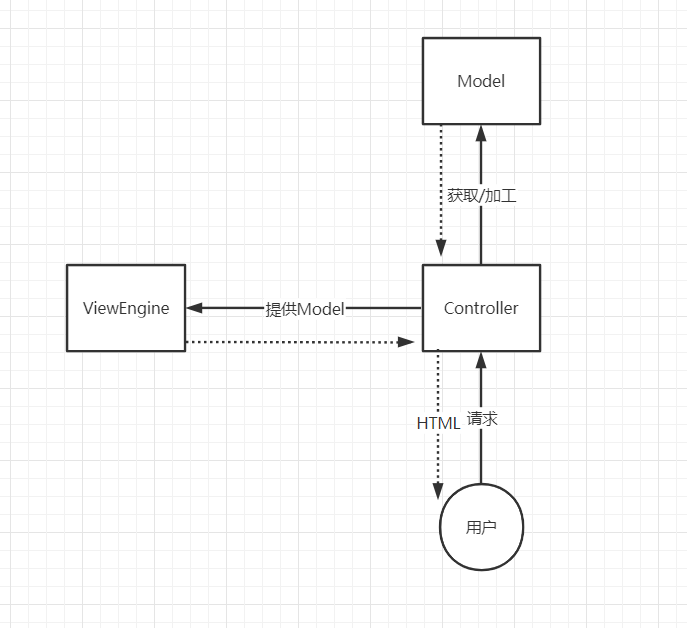.NET 云原生架构师训练营(模块二 基础巩固 MVC终结点)--学习笔记
2.3.4 Web API -- MVC终结点
- MVC与MVVM
- 模型绑定
- 自定义模型绑定器
- 模型验证
- 返回数据处理
MVC与MVVM
MVC
ASP.NET Core MVC 概述:https://docs.microsoft.com/zh-cn/aspnet/core/mvc/overview?view=aspnetcore-5.0

MVVM
ASP.NET Core 中的 Razor Pages 介绍:https://docs.microsoft.com/zh-cn/aspnet/core/razor-pages/?view=aspnetcore-5.0&tabs=visual-studio
Razor Pages 没有 Controller,Model 中可以包含方法

ASP.NET Core MVC 注入
services.AddControllers();
app.UseEndpoints(endpoints =>
{
endpoints.MapControllers();
});
MVC Endpoint

模型绑定
- 什么是模型绑定
- 来源有哪些
- 复杂的数据绑定
ASP.NET Core 中的模型绑定:https://docs.microsoft.com/zh-cn/aspnet/core/mvc/models/model-binding?view=aspnetcore-5.0
什么是模型绑定
控制器和 Razor 页面处理来自 HTTP 请求的数据。 例如,路由数据可以提供一个记录键,而发布的表单域可以为模型的属性提供一个值。 编写代码以检索这些值,并将其从字符串转换为 .NET 类型不仅繁琐,而且还容易出错。
模型绑定会自动化该过程。 模型绑定系统:
- 从各种源(如路由数据、表单域和查询字符串)中检索数据。
- Razor在方法参数和公共属性中向控制器和页面提供数据。
- 将字符串数据转换为 .NET 类型。
- 更新复杂类型的属性。
来源有哪些
- [FromQuery] -从查询字符串获取值。
- [FromRoute] -从路由数据中获取值。
- [FromForm] -从已发布的表单字段中获取值。
- [FromBody] -从请求正文中获取值。
- [FromHeader] -从 HTTP 标头中获取值。
从路由数据中获取值
[HttpGet]
[Route("option/{id}")]
public IActionResult GetOption([FromRoute] int id)
{
return Ok(new {id});
}
从查询字符串获取值
[HttpGet]
[Route("option/{id}")]
public IActionResult GetOption([FromRoute] int id, [FromQuery] string name)
{
return Ok(new {id, name});
}
从 HTTP 标头中获取值
[HttpGet]
[Route("option/{id}")]
public IActionResult GetOption([FromRoute] int id, [FromQuery] string name,[FromHeader] string termId)
{
return Ok(new {id, name, termId});
}
从已发布的表单字段中获取值
[HttpPost]
[Route("option/from")]
public IActionResult CreateOption([FromForm] string name, [FromForm] string id)
{
return Ok(new {name, id});
}
从请求正文中获取值
[HttpPost]
[Route("option/body")]
public IActionResult CreateOption([FromBody] string name)
{
return Ok(name);
}
复杂的数据绑定
- 对象
- 集合
- 字典
对象
public class Student
{
public int Id { get; set; }
public string Name { get; set; }
}
[HttpPost]
[Route("option/body")]
public IActionResult CreateOption([FromBody] Student student)
{
return Ok(student);
}
字典
[HttpGet]
[Route("option")]
public IActionResult GetOption([FromQuery] Dictionary<int, string> dic)
{
var students = new List<Student>();
foreach (var item in dic)
{
students.Add(new Student {Id = item.Key, Name = item.Value});
}
return Ok(students);
}
启动程序,访问:https://localhost:5001/config/option?dic[1001]=ming$dic[1002]=rank&dic[1003]=abc
输出:
[{"id":1001,"name":"ming$dic[1002]=rank"},{"id":1003,"name":"abc"}]
自定义模型绑定器
ASP.NET Core 中的自定义模型绑定:https://docs.microsoft.com/zh-cn/aspnet/core/mvc/advanced/custom-model-binding?view=aspnetcore-5.0
ModelBinder
[ModelBinder(BinderType = typeof(AuthorEntityBinder))]
public class Author
{
public int Id { get; set; }
public string Name { get; set; }
public string GitHub { get; set; }
public string Twitter { get; set; }
public string BlogUrl { get; set; }
}
public class AuthorEntityBinder : IModelBinder
ModelBinderProvider
public class AuthorEntityBinderProvider : IModelBinderProvider
services.AddControllers(options =>
{
options.ModelBinderProviders.Insert(0, new AuthorEntityBinderProvider());
});
模型验证
- 什么是模型验证
- 模型验证的特性与消息
- FluentValidation
什么是模型验证
ASP.NET Core MVC 和页面中的模型验证 Razor:https://docs.microsoft.com/zh-cn/aspnet/core/mvc/models/validation?view=aspnetcore-5.0
Web 应用负责检查 ModelState.IsValid 并做出相应响应
if (!ModelState.IsValid)
{
return Page();
}
模型验证的特性与消息
- [CreditCard]:验证属性是否具有信用卡格式。
- [Compare]:验证模型中的两个属性是否匹配。
- [EmailAddress]:验证属性是否具有电子邮件格式。
- [Phone]:验证属性是否具有电话号码格式。
- [Range]:验证属性值是否在指定的范围内。
- [RegularExpression]:验证属性值是否与指定的正则表达式匹配。
- [Required]:验证字段是否不为 null。
- [StringLength]:验证字符串属性值是否不超过指定长度限制。
- [Url]:验证属性是否具有 URL 格式。
- [Remote]:通过在服务器上调用操作方法来验证客户端上的输入。
[Required] [Range]
public class Student
{
[Required]
[Range(1,10,ErrorMessage = "id 为 1-10 之间的数字")]
public int Id { get; set; }
public string Name { get; set; }
}
ModelState
[HttpPost]
[Route("option/body")]
public IActionResult CreateOption([FromBody] Student student)
{
if (!ModelState.IsValid)
{
return ValidationProblem();
}
return Ok(student);
}
FluentValidation
不同场景下同一个模型有不同的验证规则,最好将模型与验证分开
表达式写法:
public class CustomerValidator : AbstractValidator<Customer> {
public CustomerValidator() {
RuleFor(x => x.Surname).NotEmpty();
RuleFor(x => x.Forename).NotEmpty().WithMessage("Please specify a first name");
RuleFor(x => x.Discount).NotEqual(0).When(x => x.HasDiscount);
RuleFor(x => x.Address).Length(20, 250);
RuleFor(x => x.Postcode).Must(BeAValidPostcode).WithMessage("Please specify a valid postcode");
}
private bool BeAValidPostcode(string postcode) {
// custom postcode validating logic goes here
}
}
Installation:https://docs.fluentvalidation.net/en/latest/installation.html
Install-Package FluentValidation
StudentValidator
namespace HelloApi.Validations
{
public class StudentValidator : AbstractValidator<Student>
{
public StudentValidator()
{
RuleFor(s => s.Id).InclusiveBetween(1,10).WithMessage("id需要在1和10之间");
}
}
}
ASP.NET Core Getting Started:https://docs.fluentvalidation.net/en/latest/aspnet.html
dotnet add package FluentValidation.AspNetCore
ConfigureServices
单个添加
services.AddControllers()
.AddFluentValidation();
// 通过依赖注入的方式(单个添加)
services.AddTransient<IValidator<Student>, StudentValidator>();
全部添加
// 通过扫描程序集的方式(全部添加)
services.AddControllers()
.AddFluentValidation(fv => fv.RegisterValidatorsFromAssemblyContaining<StudentValidator>());
返回数据处理
- 返回数据类型
- 格式化响应数据
返回数据类型
ASP.NET Core Web API 中控制器操作的返回类型:https://docs.microsoft.com/zh-cn/aspnet/core/web-api/action-return-types?view=aspnetcore-5.0
- 特定类型
- IActionResult
- ActionResult
特定类型:最简单的操作返回基元或复杂数据类型(如 string 或自定义对象类型)
IActionResult:常见返回类型为 BadRequestResult (400)、NotFoundResult (404) 和 OkObjectResult (200)
[HttpPost]
[Route("option/body")]
public IActionResult CreateOption([FromBody] Student student)
{
if (!ModelState.IsValid)
{
return ValidationProblem();
}
//return BadRequest();
//return NotFound();
return Ok(student);
}
格式化响应数据
设置 ASP.NET Core Web API 中响应数据的格式:https://docs.microsoft.com/zh-cn/aspnet/core/web-api/advanced/formatting?view=aspnetcore-5.0
浏览器和内容协商
services.AddControllers(options =>
{
options.RespectBrowserAcceptHeader = true;// 浏览器和内容协商
});
添加 XML 格式支持
services.AddControllers(options =>
{
options.RespectBrowserAcceptHeader = true; // 浏览器和内容协商
})
.AddXmlSerializerFormatters() // 添加 XML 格式支持
.AddFluentValidation();
启动程序,添加 XML Headers 访问:

添加基于 Newtonsoft.Json 的 JSON 格式支持
添加 nuget 包:Microsoft.AspNetCore.Mvc.NewtonsoftJson
services.AddControllers(options =>
{
options.RespectBrowserAcceptHeader = true; // 浏览器和内容协商
})
.AddNewtonsoftJson()// 添加基于 Newtonsoft.Json 的 JSON 格式支持
.AddXmlSerializerFormatters() // 添加 XML 格式支持
.AddFluentValidation();
GitHub源码链接:
https://github.com/MingsonZheng/ArchitectTrainingCamp/tree/main/HelloApi
课程链接
https://appsqsyiqlk5791.h5.xiaoeknow.com/v1/course/video/v_5f39bdb8e4b01187873136cf?type=2
本作品采用知识共享署名-非商业性使用-相同方式共享 4.0 国际许可协议进行许可。
欢迎转载、使用、重新发布,但务必保留文章署名 郑子铭 (包含链接: http://www.cnblogs.com/MingsonZheng/ ),不得用于商业目的,基于本文修改后的作品务必以相同的许可发布。
如有任何疑问,请与我联系 (MingsonZheng@outlook.com) 。




 浙公网安备 33010602011771号
浙公网安备 33010602011771号